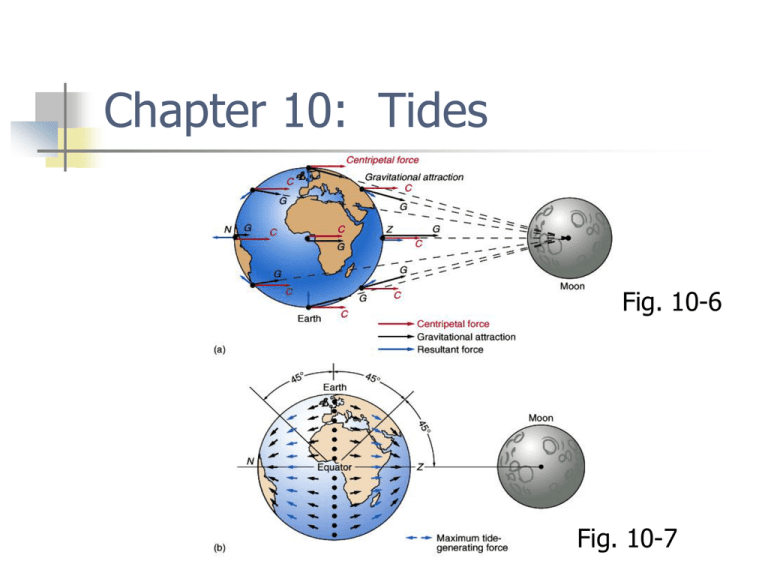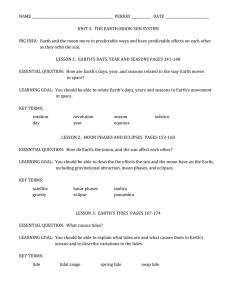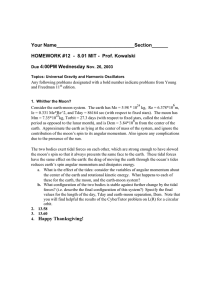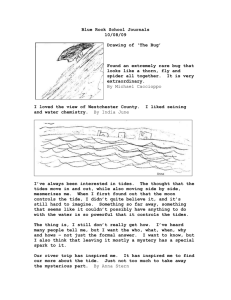Chapter 10: Tides Fig. 10-6 Fig. 10-7
advertisement

Chapter 10: Tides Fig. 10-6 Fig. 10-7 Tide-producing forces Gravity and motions among Earth, Moon, and Sun Fig. 10-2 Centripetal force “tethers” Moon to Earth Directed away from barycenter Fig. 10-4 a,b Resultant tidal forces Fig. 10-6 Fig. 10-7 Gravitational force, Earth and Moon Centripetal force, Earth and Moon Resultant force moves ocean water horizontally Tidal bulges Two equal and opposite tidal bulges Earth rotates beneath tidal bulges Two high tides Two low tides Per day Fig. 10-8 Complications to simplest equilibrium theory Oceans do not cover entire Earth Oceans do not have uniform depth Friction between ocean and seafloor Continents Moon not always in same place with respect to Earth Lunar day longer than solar day Lunar day Moon revolves around Earth Earth has to “catch up” with Moon to reach same position Fig. 10-9 Time between successive high tides shifts day after day Moon rises later each successive night Solar tidal bulges Tide-producing force of Sun less than half of Moon’s Sun much farther away Month tidal cycle Spring tides New Moon, Full Moon Earth, Moon, Sun syzygy Higher than usual high tides Fig. 10-12 Neap tide First Quarter, Last Quarter Earth, Moon, Sun quadrature Lower than usual high tide Fig. 10-12 Declination of Sun and Moon Orientation of Sun, Moon to Earth’s equator Sun 23.5o N and S, yearly cycle o Moon 28.5 N and S, monthly cycle Unequal tides Successive tides different tidal range Unequal tidal range Fig. 10-15 Elliptical orbits Perigee Lunar tidal force greater Higher high tides Apogee Lunar tidal force lesser Lower high tides Fig. 10-16 Dynamic theory of tides Tide shallow-water wave Speed varies with depth Lags behind Earth’s rotation Rotary flow in open ocean basins Amphidromic point Cotidal lines Rotary flow Crest (high tide) rotates Counterclockwise in Northern Hemisphere Clockwise in Southern Hemisphere Tidal patterns Diurnal One high, one low tide per lunar day Period of tidal cycle 24 hours 50 minutes Semidiurnal Two high, two low tides per lunar day Period 12 hours 25 minutes Equal range Mixed Two high, two low tides per lunar day Unequal range Most tides are mixed Standing waves Forced standing wave caused by tides Free-standing waves caused by strong winds or seismic disturbances Fig. 10-22 Node maximum horizontal flow Antinode maximum vertical flow Fig. 10-23 Bay of Fundy Fig. 10-24 Largest tidal range (spring tide max 17 m) Shape of basin Oscillation period close to tidal period Shoals and narrows to north Basin oriented toward right (Coriolis moves water toward right) Tidal bores Wave created by tide rushes upstream Large tidal range Low-lying coastal river Max 8 m high Fig. 10A End of Chapter 10: Tides Fig. 10-6 Fig. 10-7








